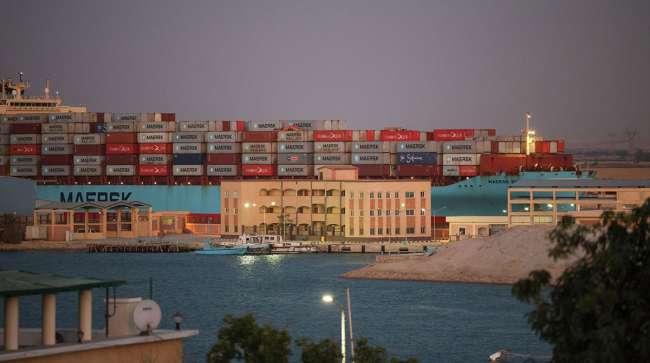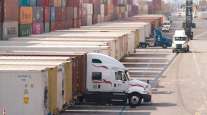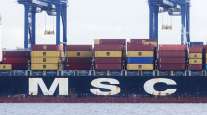Senior Reporter
Shipping Officials: Supply Chain Equipped to Deal With Attacks

[Stay on top of transportation news: Get TTNews in your inbox.]
The world’s critical shipping lanes are facing a group of modern-day “Barbary pirates” with the violence in the Red Sea, according to Federal Maritime Commissioner Carl Bentzel.
Still, shipping, port and retail leaders are optimistic the situation eventually will stabilize if the fighting in the Middle East does not accelerate.
At the same time, the risks are high. The lessons learned from the COVID-19 pandemic will keep the supply chains open through this latest crisis, using alternative routes and assistance from the U.S. military and other nations to keep the ships moving.
That was one of the conclusions from a Feb. 7 advisory hearing by FMC on risks to the international economy. Members wanted to hear testimony on the recent violence by Houthi rebels in Yemen and others, backed by Iran. Their targets are shipping lanes and cargo ships owned by companies they say have ties to Israel and the U.S.
“The Houthi attacks on merchant shipping predominantly in the Red Sea endanger life and property, regardless of destination or origin, and are the biggest impingement on freedom of the seas in decades,” FMC Chairman Daniel Maffei said in his opening statement. “The United States economy depends on ocean shipping to provide reliable, efficient and affordable access to global markets for American importers and exporters. No economy has the luxury of having ships sit idle until it is safe to transit the Suez Canal again. Trade must and will continue.”
Maffei added that he is concerned that once-in-a-lifetime “Black Swan” events are becoming more frequent, forcing transportation and retail leaders to find new, more creative ways to move cargo at a fair price.

Bentzel
Bentzel pointed out that ocean carriers move more than 90% of the country’s international trade, and rerouting ships out of the Red Sea and far south to the Horn of Africa will significantly increase costs and add days to the journey.
But, he said, the situation can be overcome.
“I believe there is some good news. In the present, cargo is moving smoothly. There is some additional capacity at the marine terminals, and the equipment providers and intermodal rail and trucking are aware that we could face challenges as the ocean carriers adjust to new shipping patterns,” Bentzel said. “Ocean carriers have ship orders being delivered that can be plugged to help address the reduced shipping capacity, and we have a little bit of time. Ocean shipping events tend to lag as cargo delivery today brings cargo on the seas for four to five weeks, so there is a lag.”
But Bentzel said he is concerned because shipping conditions will change by the summer, and the longer the attacks persist, the worse the situation will become.
To that end, an official with the National Retail Federation said that while it is early February, retailers are beginning to plan for the summer and fall retail sales season and even the Christmas shopping season.

Gold
Jonathan Gold, NRF’s vice president for supply chain and customs policy, testified that shippers have increased prices between 38% and 73% to move items through the Red Sea. Some shippers are imposing surcharges, even for items that are not scheduled to go through the Red Sea.
“The retailers are making decisions now concerning the back-to-school and holiday shipments,” Gold said. “These strategies include shipping cargo around the Cape of Good Hope. We have seen a shift in our members going back to using the ports on the West Coast and then using intermodal rail to get the items to the East Coast, where they need to go.
“More challenges are coming, and the federal government needs to be working now to help avoid congestion in the coming months.”
Gold said there is evidence that West Coast ports could see a surge in cargo volume this summer if the violence does not abate.

Cordero
Port of Long Beach CEO Mario Cordero, a former FMC chairman, told the agency that the two Southern California ports have the capacity to handle additional cargo and said there has been a month-to-month uptick as more freight moves through Long Beach and the adjacent Port of Los Angeles.
“This is another unforeseen event impacting the supply chain,” Cordero said. “The threat to international shipping posed by the events in the Red Sea is indeed critical. The current situation threatens the very network of international commerce. We and our supply chain partners are prepared for any diversion of cargo that may occur due to the situation in the Red Sea.”
Cordero pointed to December, when Long Beach reported a 30.4% year-over-year increase by processing 709,819 containers compared with 544,104 in the 2022 period.
Did you miss the live webcast of the 2024 State of the Port? You’re in luck, you can watch a replay of the program on our website! Take a watch and learn why #POLB CEO Mario Cordero is optimistic for an excellent 2024. https://t.co/YJqbOlIX4D pic.twitter.com/1XHGK0tMv3 — Port of Long Beach (@portoflongbeach) January 22, 2024
He added that the port is better prepared now than it was four years ago at the onset of the COVID-19 pandemic, noting the billions of dollars invested in the ports from the Infrastructure Investment and Jobs Act and the railroad and trucking industry. Cordero said at his facility, there already have been two significant upgrades to its intermodal rail network, and another major rail yard is in the planning stages.
Want more news? Listen to today's daily briefing below or go here for more info:




